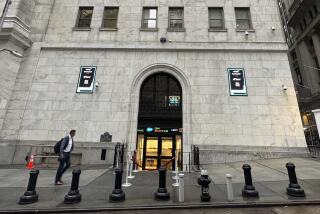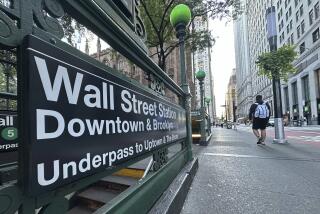Dow Gains 14 to Barrel Past the 2,100 Mark : Hits Post-Crash High on 6th Advance in Row
NEW YORK — The stock market hit a post-crash high Tuesday in its sixth-straight advance, helped by a late wave of computerized buying which sent the Dow average over the 2,100 mark at the close.
The Dow average of 30 industrials jumped 14.09 points to 2,110.08, bringing its gain in the week-old rally to a total of about 130 points. Broader market gauges also moved upward.
This is the longest winning streak since the bull market’s height last year when eight straight gains put the Dow at 2,572.07 on July 31.
Computer-triggered buy programs, a firmer dollar and rebounding bond prices all were credited with spurring the advance.
Gaining issues outnumbered losers by about 7 to 5 on the New York Stock Exchange.
Big Board volume totaled 146.40 million shares, against 146.37 million shares in the previous session. The NYSE’s composite index gained 0.72 to 153.19.
Analysts noted that volume remained extremely light, initially indicating a lack of investor enthusiasm but then serving to accentuate the move upward once buyers stepped in.
Stocks were mixed early in the session and the market appeared to lack direction.
The Dow average tentatively touched 2,100 around noon but quickly retreated. It was not until the key market barometer held above that level in mid-afternoon that investors discarded their inhibitions over equities.
“When the Dow went above 2,100 decisively, it attracted new buyers,” said Michael Metz, a vice president and technical analyst with Oppenheimer & Co.
The 2,100 mark had become somewhat of a psychological barrier. The Dow average flirted with that level on several recent occasions, but investors seemed reluctant to make it stick.
“There is cautious optimism . . . but there is also a lot of room for disappointment,” said Jon Groveman of Ladenburg Thalmann & Co.
Traders said a firm dollar and bond market reflected widespread speculation that the trade deficit figure, due Thursday, will be narrowed at least to the consensus forecast of $11.5 billion for February after a $12.4 billion shortfall for January.
Gary Ciminero, an economist at Fleet Financial Group, said the market “may be more passive than ever if the (trade) deficit shows improvement in line with the consensus. Only if it is trouble will the market respond.”
The rally sped up in late afternoon when the market made its first clear penetration of resistance at the 2,100 level, unleashing computerized and other technical buying.
“There is a substantial amount of cash on the sidelines waiting for a buy opportunity,” said Alan Ackerman, an analyst with Gruntal & Co.
“A lot of market watchers are getting nervous that they missed something on the upside,” Metz said referring to the many investors who sat on the sidelines awaiting fresh economic data due out later this week.
“A lot of people have missed this move,” he said.
Some inactive investors hoped the Commerce Department’s release of February’s merchandise trade data on Thursday would lend clues to the state of the economy.
Many were playing it “close to the vest until they see some direction from the numbers coming out,” said Peter Vandenberg, a vice president at Smith Barney, Harris, Upham & Co.
Besides the trade figures, retail sales figures were due out Wednesday, the same day the so-called Group of Seven industrialized nations was set to hold a meeting that could have implications for the dollar.
Among actively traded issues, Honda Motor was the exception in an otherwise lackluster auto sector, jumping 4 to 147 1/2.
Aircraft issues were mixed. Boeing was unchanged at 47 3/8. The Federal Aviation Administration said it would conduct an investigation into alleged defects in the some of the company’s wide-body jets.
Electronic issues were mostly higher, with Honeywell up 1 3/8 to 70; Kyocera up 2 to 90, and Matsushita up 3 3/8 to 226 7/8.
Shares of National Semiconductor Corp. were heavily traded after a mutual fund group disclosed that it owns 5.3% of the company’s stock. The Santa Clara, Calif.-based company’s stock closed up 12 1/2 at 13 3/8 and was the third most actively traded stock on the NYSE.
Oil stocks were widely higher, with Chevron up 1 1/2 to 50 3/4, Mobil up 1 1/8 to 49 1/8 and Atlantic Richfield up 1 1/8 to 90 3/8. Oil prices hit a four-month high in the second day of a rally inspired by OPEC efforts to rein in supplies.
The Wilshire index of 5,000 equities closed at 2,691.343, up 12.470 from Monday’s close.
Nationwide turnover in NYSE-listed issues, including trades in those stocks on regional exchanges and in the over-the-counter market, totaled 171.75 million shares.
Standard & Poor’s index of 400 industrials rose 1.45 to 316.16 and S&P;’s 500-stock composite index was up 1.21 to 271.37.
At the American Stock Exchange, the market-value index rose 2.90 to 306.59. The NASDAQ composite index for the over-the-counter market closed at 383.38, up 0.86.
In foreign trading, stocks closed mixed in Tokyo on Tuesday as investors took a cautious approach to trading while waiting to see what will come of a Group of Seven meeting today. The Nikkei 225-share index rose 5.97 points to finish 26,930.84. It climbed 175.98 points Monday.
In London, share prices ended slightly lower in thin, featureless trading Tuesday, as investors awaited news from a meeting of monetary officials of the Group of Seven major industrialized nations.
The Financial Times 100-share index closed down 5.2 points at 1,805.3.
More to Read
Inside the business of entertainment
The Wide Shot brings you news, analysis and insights on everything from streaming wars to production — and what it all means for the future.
You may occasionally receive promotional content from the Los Angeles Times.










